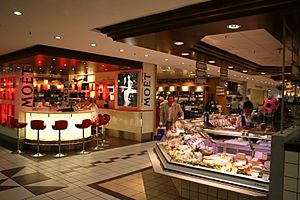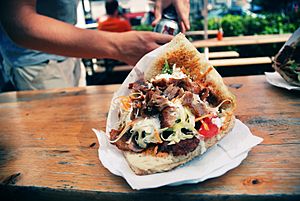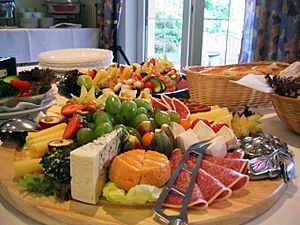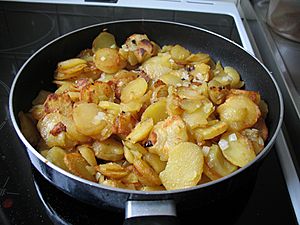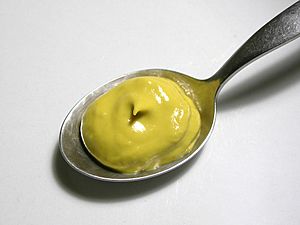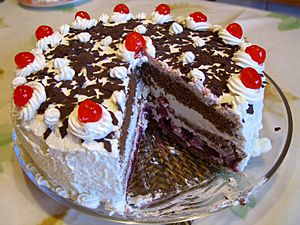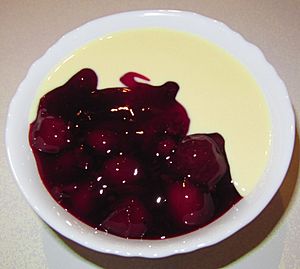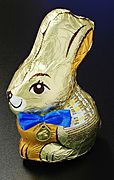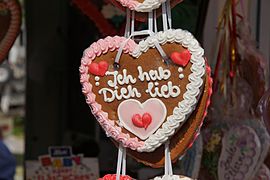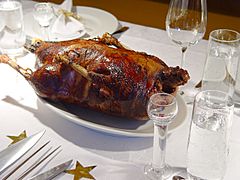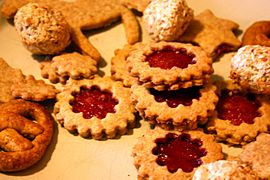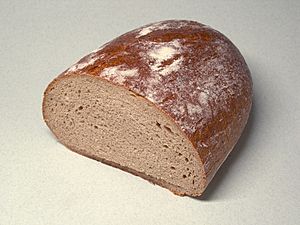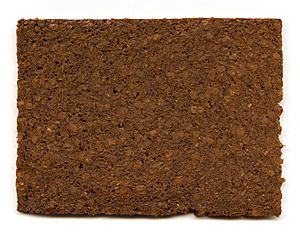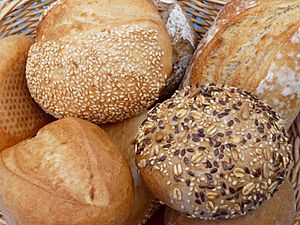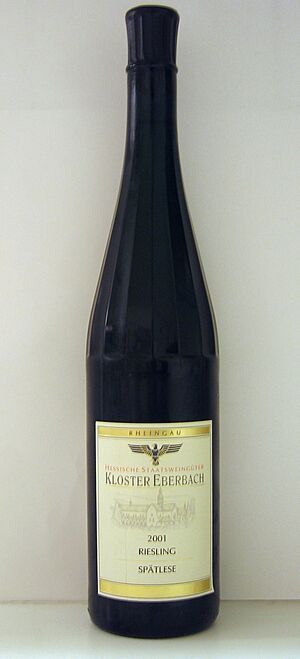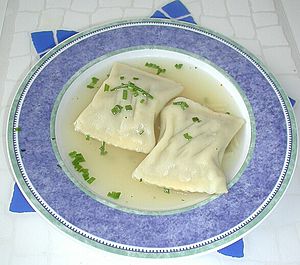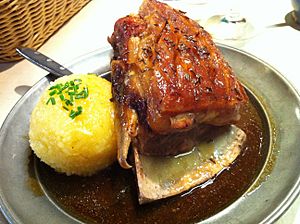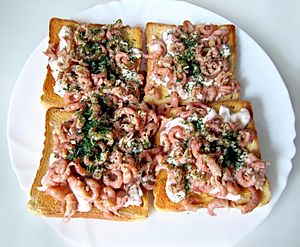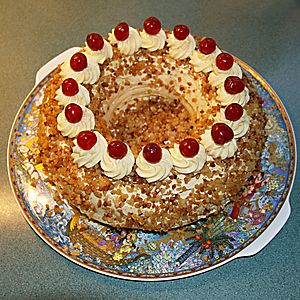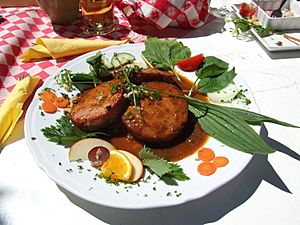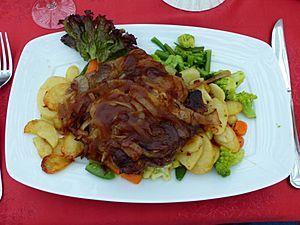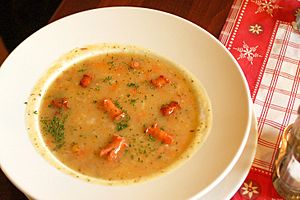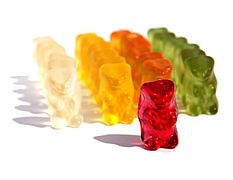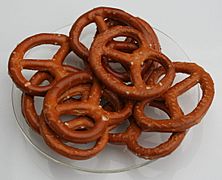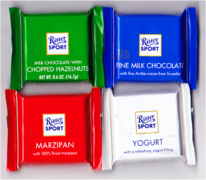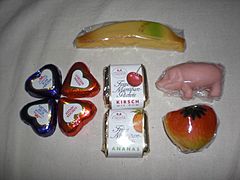German cuisine facts for kids
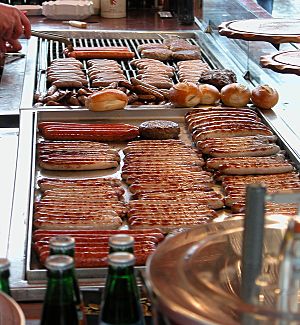
German food, called cuisine of Germany (or German: Deutsche Küche in German), is super diverse! This is because Germany has a long history of different regions, each with its own special dishes. Germany is in Central Europe, so its food shares many traditions with nearby countries like Poland, the Czech Republic, Austrian cuisine, and parts of Swiss cuisine.
Germany is also known for its amazing restaurants. In 2015, the famous Michelin Guide gave its highest award (three stars) to 11 restaurants in Germany. Many more received two or one stars, showing how good German cooking is!
Contents
Hot Foods to Try
Meats in German Meals
Germans eat a lot of meat, about 59.7 kilograms (131 pounds) per person each year! The most common meats are pork, chicken, and beef.
Source: Statista.com, 2017
Meat is often slow-cooked until it's super tender. One famous dish is Sauerbraten, which means "sour roast." It's made by marinating beef, horse meat, or venison in a vinegar mix for several days. This makes the meat incredibly soft and flavorful.
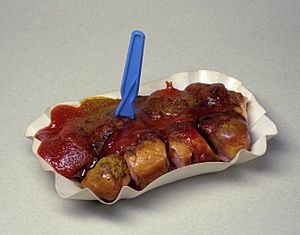
Germany is famous for its sausages! There are over 1,500 different kinds of sausage (called German: Wurst). Most are made with natural casings. Some popular ones include Bratwurst (usually pork and spices), Wiener (smoked pork or beef sausage), and Blutwurst (blood sausage).
Many regions have their own special sausages. For example, the Münchner Weißwurst (Munich white sausage) is popular in Bavaria. The Currywurst, a sausage with curry ketchup, is a favorite fast food in cities like Berlin and Hamburg. Another very popular fast food is döner kebab, with sales reaching over 3.5 billion euros each year!
Fish Dishes
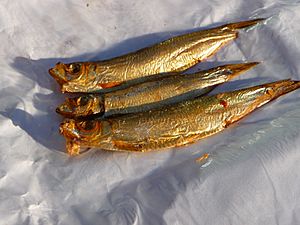
While meat is very popular, fish is also a big part of German food. For saltwater fish, Alaska pollock is eaten most often. Popular freshwater fish include trout, pike, carp, and European perch.
In the past, seafood was mostly eaten in northern coastal areas. Dishes like pickled herring (often in a Fischbrötchen sandwich), Rollmops (pickled herring rolled around a gherkin), or Brathering (fried, marinated herring) were common.
Today, many sea fish like fresh herring, tuna, mackerel, and salmon are enjoyed all over Germany. Fischstäbchen (fish sticks), made from whitefish like cod or pollock, are also a popular processed food.
Vegetables on the Plate
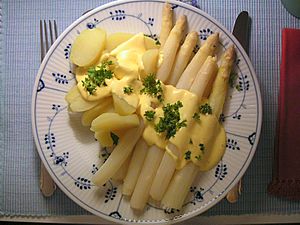
Vegetables are often used in stews or soups. They are also served as side dishes with main meals. Common vegetables include carrots, cauliflower, spinach, peas, beans, broccoli, and many types of cabbage. Fried onions are often added to meat dishes.
Asparagus is a very popular seasonal vegetable, especially the white kind. Germans eat about 1.5 kilograms (3.3 pounds) of asparagus per person each year! Restaurants often have special menus just for white asparagus when it's in season. The asparagus season (German: Spargelzeit) usually runs from mid-April to June 24th.
How Germans Eat Their Meals
Breakfast (Frühstück) is usually a big meal. It often includes bread, toast, or bread rolls with butter, cold meats, cheeses, jam, honey, and boiled eggs. People drink coffee, tea, milk, cocoa, or fruit juices. It's common to have hearty toppings like ham, salami, liver sausage (Leberwurst), and various cheeses. Many bakeries sell belegte Brötchen (sandwiches made from bread rolls) for people on the go.
Traditionally, lunch (Mittagessen) was the main meal, eaten around noon. Dinner (Abendessen or Abendbrot) was a smaller meal, often just bread, meat, cheese, and some vegetables, similar to breakfast. Germans also enjoy Kaffee und Kuchen (coffee and cake) in the afternoon, especially on Sundays with family. It's like the English five-o'clock tea.
However, eating habits have changed. Many people now eat a small lunch at work and have a hot dinner at home with their family in the evening. But the traditional big breakfast and coffee and cake time are still very popular, especially on weekends.
Side Dishes to Enjoy
Noodles, made from wheat flour and egg, are common. They are usually thicker than Italian pasta. In southwestern Germany, Spätzle (noodles made with lots of eggs) and Maultaschen (stuffed noodles like ravioli) are popular.
Potatoes are also a very common side dish. They became popular in German cooking in the late 1600s. They are often boiled (Salzkartoffeln), mashed (Kartoffelpüree), or pan-fried (Bratkartoffeln). French fries (Pommes frites) are also popular, usually served with ketchup or mayonnaise.
You'll also find dumplings (Klöße or Knödel) and potato noodles like Schupfnudeln, which are similar to Italian gnocchi. Salads and vegetarian dishes are also becoming more popular.
Spices and Sauces
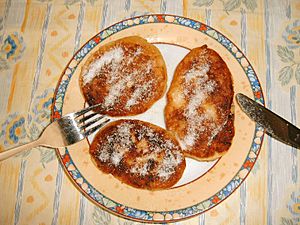
German dishes are usually not very spicy. The most common herbs and spices are parsley, thyme, laurel, chives, black pepper, juniper berries, nutmeg, and caraway. Spices like cardamom, anise seed, and cinnamon are often used in sweet cakes or Christmas drinks. Fresh dill is often used in salads or with fish.
Mustard (Senf) is a very common sauce for sausages. It comes in different strengths, with Mittelscharf (medium hot) being the most common. In the southern parts of Germany, a sweet mustard is served with Weißwurst.
Horseradish is another common condiment, either as a paste or mixed with cream. It's sometimes used with meats and sausages instead of mustard. Garlic wasn't traditionally a big part of German cooking but has become more popular thanks to influences from French, Italian, and Turkish foods.
Sweet Desserts
Germany has a huge variety of cakes, tarts, and pastries, often made with fresh fruit like apples, plums, strawberries, and cherries. Cheesecake is also very popular, often made with a soft cheese called quark. The Schwarzwälder Kirschtorte (Black Forest cake), made with cherries, is one of the most famous German cakes.
German doughnuts (which don't have a hole) are usually balls of yeast dough with jam or other fillings. They are known as Berliner, Pfannkuchen, Kreppel, or Krapfen, depending on the region. Eierkuchen or Pfannkuchen are large, thin pancakes, similar to French crêpes. They are served with sugar, jam, or syrup.
A popular dessert in northern Germany is Rote Grütze, a red fruit pudding made with currants, raspberries, and sometimes strawberries or cherries. It's usually served with cream, vanilla sauce, or milk.
Ice cream and sorbet are also very popular. Italian ice cream shops started appearing in Germany in the mid-1800s. Spaghettieis, an ice cream dessert that looks like spaghetti with tomato sauce and cheese, is a fun and popular treat!
Holiday Foods
On the Christmas Days after Christmas Eve, roast goose is a traditional meal. Sometimes, especially in southern areas, it's replaced with European carp, which is fried and served with potato salad or cucumber salad.
-
Chocolate Easter Bunny
Many Christian holidays have special dishes. For Easter, people enjoy painted Easter eggs, Osterbrot, and freshwater fish on Good Friday. Saint Sylvester's Day (New Year's Eve) is often celebrated with a carp meal. The time before Easter, called carnival season, is known for Pfannkuchen (doughnuts). The Advent season before Christmas is associated with sweet and spicy foods like Weihnachts- or Christstollen (Christmas bread) and Lebkuchen (gingerbread).
German Breads
Bread (Brot) is a very important part of German food. Germany has the most types of bread in the world, with about 3,000 different kinds of breads and 1,200 types of pastries and rolls!
Bread is usually eaten for breakfast (often with bread rolls) and in the evening as open sandwiches. It's rarely a side dish for the main meal, but it's popular with stews or soups. The importance of bread is shown by words like Abendbrot (supper, literally "evening bread") and Brotzeit (snack, literally "bread time").
German bread is very varied. It ranges from white wheat bread (Weißbrot) to dark brown rye bread (Schwarzbrot). Many breads mix wheat and rye flour (Mischbrot) and often include whole grains and seeds like linseed, sunflower seed, or pumpkin seed (Vollkornbrot). Darker, rye-heavy breads like Vollkornbrot and Schwarzbrot are typical. Pumpernickel, a sweet-tasting bread made by long steaming, is famous worldwide. Most German breads are made with sourdough.
Germany's most popular breads include rye-wheat, toast bread, whole-grain, and various breads with sunflower or pumpkin seeds.
Bread Rolls
Bread rolls, called Brötchen (meaning "little bread"), are very common. They are often cut in half, spread with butter, and filled with cheese, honey, jam, or cold meats. Rolls are also used for snacks or as a bun for Bratwurst.
Franzbrötchen, from Hamburg, is a small, sweet pastry roll baked with butter and cinnamon.
Drinks in Germany
Alcoholic Drinks
Beer is very popular all over Germany. There are many local breweries making a wide range of beers. The light beer called pilsner is most common today. Wheat beer (Weißbier) and other types of lager are also popular, especially in Bavaria. Some regions have special beers, like Altbier in Düsseldorf or Kölsch in Cologne. Beer can also be mixed with other drinks, like lemonade to make a Radler (cyclist).
Cider is also popular, called Most or Ebbelwoi. In Hessen, people drink it from a special jug called a Bembel.
Wine is also enjoyed, especially from areas along the Rhine river. Riesling and Silvaner are well-known white wines, while Spätburgunder and Dornfelder are important red wines.
Korn, a German spirit made from grains, is popular in central and northern Germany. Obstler, made from fruits like apples, pears, or cherries, is preferred in the south. The word Schnaps refers to strong alcoholic drinks.
Non-alcoholic Drinks
Coffee is very common, not just for breakfast but also in the afternoon with cake (Kaffee und Kuchen). It's usually filter coffee. Coffeeshops are popular. Tea is more common in the northwest, especially in East Frisia, where it's traditionally served with cream and rock candy. Germany has one of the highest coffee consumptions in the world.
Popular soft drinks include Schorle, which is juice or wine mixed with sparkling mineral water. Apfelschorle (apple juice mixed with sparkling water) is popular everywhere. Spezi is a mix of cola and orange soda. Germans often prefer bottled, carbonated mineral water over still water.
Drinking water from the tap in Germany is of excellent quality and safe to drink everywhere.
Regional German Food
German food changes a lot from one region to another. For example, there's Bavarian cuisine in the south and Thuringian food in central Germany.
Baden-Württemberg
This state in southwest Germany has two main food styles: Baden and Swabian. Baden has a warm climate and good soil, leading to many high-quality restaurants. Swabian food tends to be a bit heavier. Famous dishes from Baden-Württemberg include Maultaschen (stuffed noodles), Spätzle (egg noodles), and Black Forest cake.
Bavaria
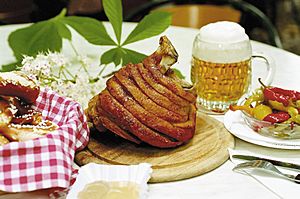
Bavarian food was developed by royal families and is connected to Czech and Austrian cooking. A special Bavarian snack is the Brotzeit, eaten between breakfast and lunch. Bavaria is known for its beet and potato crops, and for making great beers.
Franconia
Franconia, in northern Bavaria, has its own distinct food. People even joke about a "White Sausage Equator" because they don't usually eat the Weißwurst popular in southern Bavaria. Franconian food often includes rich gravies, potato dishes, and various meats. A good example is Schäufele and Klöße, which is pork shoulder with potato dumplings covered in gravy.
Hamburg
Hamburg, being a port city for centuries, has very diverse food. It traditionally had lots of different fish from the Elbe river and easy access to the North Sea and Baltic Sea. International trade brought spices and exotic foods from Asia and South America starting in the 1500s, which were quickly added to local cooking. Hamburg is also known for its many international gourmet restaurants.
Hessen
Typical dishes from Hessen include Frankfurter Rippchen, a pork cutlet often served with sauerkraut and mashed potatoes. Also from Hessen is the Frankfurt green sauce ("Grüne Sauce"), a cold sauce made with sour cream and local herbs. It's often served with potatoes and boiled eggs.
One of the most famous desserts from Hesse is the Frankfurter Kranz, a buttercream cake shaped like a crown. Cider ("Apfelwein") is also very popular in and around Frankfurt. In the Cider Quarter, you can find taverns that serve cider and "Handkäs mit Musik", a sour milk cheese with onions and spices.
Palatinate/Pfalz
The food in the Palatinate region is often hearty. A well-known dish is the Pfälzer Saumagen, a pork stomach stuffed with sausage meat, bacon, potatoes, and spices. This dish became famous as the favorite meal of former German Chancellor Helmut Kohl.
In the Palatinate, the salty-crust Dampfnudel (steamed dumpling) is a traditional main dish. It can be eaten with sweet sauces (like wine sauce or custard) or with savory dishes (like potato soup or goulash).
Thuringia
This region grows wheat, grapes, sugarbeets, and barley, along with many vegetables like cauliflower, cabbage, and broccoli. Thuringia is also a big herb-growing region.
One-third of Thuringia is covered in forest, making it a great place for hunting game like red deer, roe deer, and wild boar. The forests also have many edible mushrooms and wild berries like blueberries and raspberries, which are often served with game dishes.
The most famous foods from Thuringia are Thuringian sausages and Thuringian dumplings. The state is known for its many types of sausages, including Thüringer Mettwurst (a spreadable sausage) and Thüringer Leberwurst (liver sausage).
Saxony
Saxon food is very hearty and uses many sauces with main dishes. They often serve Klöße or Knödel (dumplings) instead of potatoes or pasta. Many freshwater fish like carp and trout are used in Saxon cooking.
The region's history influences its food. In cities like Dresden and Leipzig, you'll find more fancy dishes. In poorer areas, simple peasant dishes like potatoes with Quark (a type of cheese) or potato soup are common.
International Food in Germany
International foods are a newer trend in German cuisine. In the 1800s, shops started bringing in luxury items like cocoa, coconuts, and exotic spices.
After World War II, with more foreign workers coming to Germany, many international dishes became popular. Italian foods like spaghetti and pizza are now staples. In 2008, there were around 9,000 pizzerias in Germany, and pizza is Germany's favorite fast food!
Turkish immigrants brought döner kebab, which is now incredibly popular. In November 2017, there were about 16,000 döner kebab shops across Germany.
Arab, Chinese, Japanese (especially Sushi), and Greek (especially Gyros) restaurants are also common. More recently, Indian, Vietnamese, and Thai foods have become very popular.
Before 1990, food in East Germany was influenced by other countries in the former Communist bloc. For example, Russian Soljanka became a typical East German dish.
Food Industry in Germany
Germany is a big player in agriculture, being the third largest producer in the European Union and the third largest exporter of farm products in the world. Many German food products are well-known brands internationally.
-
Mini pretzels
See also
 In Spanish: Gastronomía de Alemania para niños
In Spanish: Gastronomía de Alemania para niños


